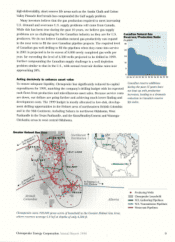Chesapeake Energy 1998 Annual Report Download - page 20
Download and view the complete annual report
Please find page 20 of the 1998 Chesapeake Energy annual report below. You can navigate through the pages in the report by either clicking on the pages listed below, or by using the keyword search tool below to find specific information within the annual report.
Glossary of Terms
Bcf Billion cubic feet of natural gas.
Bcfe Billion cubic feet of natural gas equivalent.
Bbl One stock tank barrel, or 42 U.S. gallons liquid
volume, used herein in reference to crude oil or
other liquid hydrocarbons.
Ceiling Test Writedown A non-cash charge
to earnings mandated by the Securities and
Exchange Commission for companies utilizing
the full-cost method of accounting. Under the
full-cost method of accounting, all costs of acqui-
sition, exploration and development of oil arid
gas reserves are capitalized into a "full-cost
pool," and properties in the pool are depleted
and charged to operations using the unit-of-
production method based on the ratio of current
production to total proved oil and gas reserves.
To the extent that such capitalized costs (net of
accumulated depreciation, depletion and amorti-
zation) less deferred taxes exceed the present
value (discounted at 10%) of estimated future
net cash flows from proved oil and gas reserves
and the lower of cost or fair value of unproved
properties after income tax effects, the excess
is charged to operations in the current period.
However, such charges do not have an impact
on cash flows from operating activities. Once
incurred, a writedown of oil and gas properties
is not reversible, even if oil and gas prices sub-
sequently increase,
Commingled Well A well producing from two
or more formations through a common well
casing and a single tubing string.
DD&A Depreciation, depletion and amortization.
Developed Acreage Ihe number of acres which
are allocated or assignable to producing wells
or wells capable of production.
Development Well A well drilled within the
proved area of an oil or gas reservoir to the depth
of a stratigraphic horizon known to be productive.
Downdip Wells Wells producing from deeper
depths lower on a structure than updip wells.
Dry Hole; Dry Well A well found to be incapable
of producing either oil or gas in sufficient quan-
tities to justify completion as an oil or gas well.
Exploratory Well A well drilled to find and
produce oil or gas in an unproved area, to find
a new reservoir in a field previously found to
be productive of oil or gas in another reservoir,
or to extend a known reservoir.
Full-Cost Pool The full-cost pool consists of
all costs associated with property acquisition,
exploration, and development activities for a
company using the full-cost method of account-
ing. Additionally, any internal costs that can be
directly identified with acquisition, exploration
and development activities are included. Any
costs related to production, general corporate
overhead or similar activities are not included.
Finding Costs The capital costs associated with
finding and developing oil and gas reserves.
Formation An identifiable single geologic horizon.
Fracture Stimulation Action taken to increase
the inherent productivity of a prospective for-
mation through the hydraulic injection of water,
diesel or CO2 at high rates.
G&A Expenses General and administrative
expenses.
Gross Acres or Gross Wells The total acres or
wells, as the case may be, in which a working
interest is owned.
Horizontal Wells Wells which are drilled at
angles greater than 70 degrees from vertical.
Increased Density A well drilled in addition
to the number of wells permitted under normal
spacing regulations to accelerate recovery or
prevent loss of reserves.
Independent Producer A nonintegrated
producer of oil and gas with no refining or
retail marketing operations.
Lease Operating Expenses (LOE) The costs
of maintaining and operating property and
equipment on a producing oil and gas lease.
MBbls One thousand barrels of oil.
Mcf One thousand cubic feet of natural gas.
MMcf One million cubic feet of natural gas.
MMcfe One million cubic feet of natural gas
equivalent; a unit of measurement which com-
bines oil, natural gas liquids, and natural gas.
Oil and natural gas liquids are converted to
natural gas based upon their relative energy
content at the rate of 6 mcf for each barrel of
oil or natural gas liquids.
Operating Costs Ihe sum of lease operating
costs. p n do lion taxes and G&A expenses.
Net Acres or Net Wells The sum of frac-
tional working interest owned in gross acres
or gross wells.
Payzone The producing formation(s) of a well.
Present Value When used with respect to oil and
gas reserves, present value is the estimated
future gross revenue to be generated from the
production of proved reserves, net of estimated
production and future development costs, using
prices and costs in effect at the determination
date, without giving effect to non-property
related expenses such as general and admin-
istrative expenses, debt service and future
income tax expense or to depreciation deple-
tion and amortization, discounted using an
annual discount rate of 10%.
Productive Well A well that is producing oil
or natural gas or that is capable of production.
Proved Developed Reserves Reserves that
can be expected to be recovered through exist-
ing wells with existing equipment and operat-
ing methods.
Proved Reserves The estimated quantities of
crude oil, natural gas and natural gas liquids
which geological and engineering data demon-
strate with reasonable certainty to be recover-
able in future years from known reservoirs under
existing economic and operating conditions.
Proved Undeveloped Location A site on which
a developnient well can be drilled consistent
with spacing rules for purposes of recovering
proved undeveloped reserves.
Proved Undeveloped Reserves Reserves that are
expected to be recovered from new wells drilled
to a known reservoir(s) on undrilled acreage or
from existing wells where a relatively major
expenditure is required for recompletion.
Reserve Life The term in years required
to deplete the company's proved oil and gas
reserve base at current production rates.
Royalty Interest An interest in an oil and gas
property entitling the owner to a share of oil
or gas production free of costs of production.
3-D Seismic Advanced technology method
of detecting accumulations of hydrocarbons
identified by the collection and measurement
of the intensity and timing of sound waves
transmitted into the earth as they reflect
back to the surface.
Tcf One trillion cubic feet of natural gas.
Tcfe One trillion cubic feet of natural gas
equivalent.
Undeveloped Acreage Lease acreage on which
wells have not been drilled or completed to a
point that would permit the production of com-
mercial quantities of oil and gas regardless of
whether such acreage contains proved reserves.
Working Interest The operating interest which
gives the owner the right to drill, produce and
conduct operating activities on the property
and a share of production.
With the number of asset impairment charges
incurred by the company over the past two years
as oil and natural gas prices have declined and
the company sharply reduced its Louisiana
Austin Chalk drilling pro yram, maoy investors
have inquired about the different oil and gas
accounting methods and rules that affect energy
producers. The following provides some explana-
tion of the related issues.
Full-cost versus successful-efforts accounting
Oil and gas companies are allowed to use either
of two accounting methods - full cost or success-
ful efforts. Although both methods follow the
accounting principles of matching, realization,
and cost, they differ materially on how impair-
ments are caused.
Impairments, or the writedown in value of
oil and gas properties, are principally caused by
temporary downturns in oil and gas prices which
significantly reduce reserve values because the
SEC requires a company to value its reserve base
using end-of-quarter prices in lieu of historical
averages, future expectations or other concepts
that attempt to capture the intrinsic long-term
value of a company's reserves. Under full-cost
accounting, impairment charges against the book
value of oil and gas assets are typically larger
and more frequent than under successful-efforts
accounting largely due to the requirement that
full-cost companies use the discounted (at 10%)
stream of future revenue to compare against the
book value of the properties. Successful-efforts
companies, on the other hand, are not subject to
the same requirement to discount the future rev-
enue stream. The difference in the two methods
is magnified when applied to assets with espe-
cially long expected production lives. In cases of
extremely long-lived properties (productive lives
of more than 40 years such as Chesapeake's
Hugoton Field and West Panhandle Field assets),
as much as 50% of the total reserves may be
determined uneconomic at today's constant,
discounted prices and are thus eliminated from
the reserve report in spite of their substantial
future value.
Furthermore, in addition to the adverse
income statement impact caused by the impair-
ment charges, a producer's balance sheet is
similarly negatively affected. The category of
Stockholders' Equity is permanently reduced in
periods of low prices, but is not revised upward
when prices increase. Another peculiar result
is the reappearance of "phantom" reserves
in future years. These are reserves that are
deducted from the reserve report when prices
are unfavorable but are added back to the
reserve report when prices become more favor-
able. The overall existence of the physical
reserves does not change, but the economic
viability of the reserves can come and go. An
important mitigating benefit of the impairments
is that future earnings are enhanced because
future depreciation rates are lower than they
would have been without the writedowns.
























